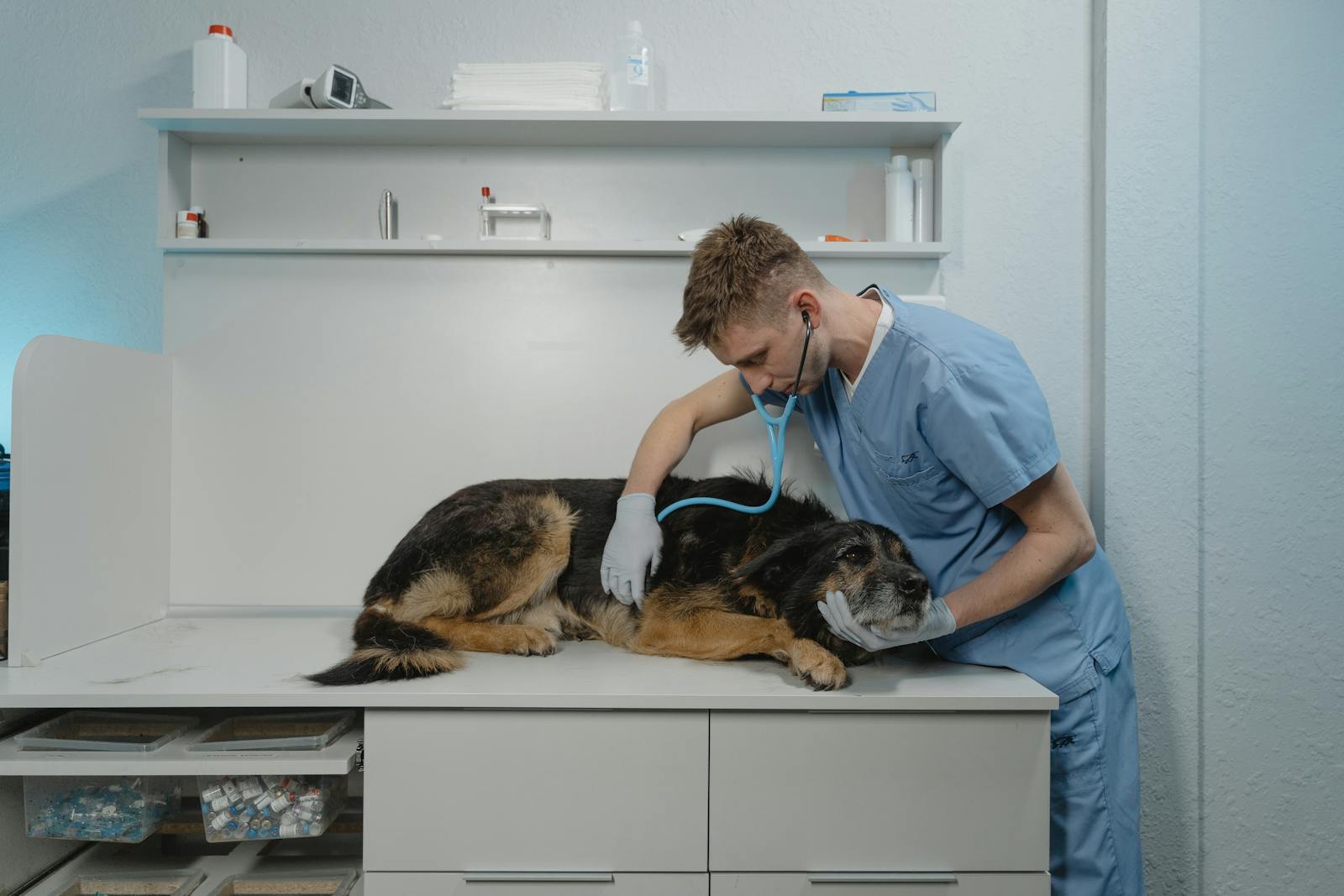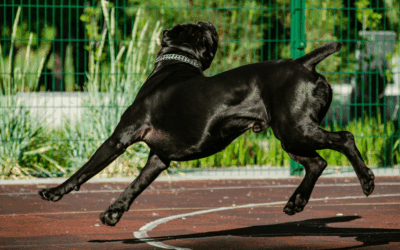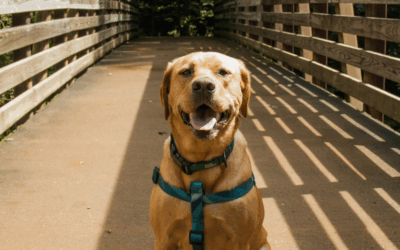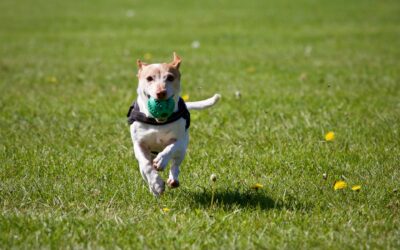Is your four-legged friend scratching more than usual? Have you noticed hair loss or mysterious patches on their skin? Your dog might be dealing with ringworm, a common skin condition that affects dogs of all breeds and ages. Despite its misleading name, ringworm isn’t caused by a worm but by a fungal infection that can affect not only dogs but humans and other pets too. It is crucial to consult qualified veterinary medicine for effective treatment of ringworm in dogs.
This blog walks you through everything you need to know about ring worms in dogs, from understanding what it is and how it spreads to diagnosing and treating the infection. By the end of this article, you’ll know how to protect your dog and your family from this pesky fungus.
What is Ringworm?
Ringworm, also known as dermatophytosis, is a fungal infection that affects the skin, hair, and sometimes even the nails of dogs. The infection is caused by specific fungal species such as Microsporum canis, Microsporum gypseum, and Trichophyton mentagrophytes. The fungus Microsporum canis is the primary cause of ringworm infections in dogs.
Ringworm thrives by feeding on keratin, a protein found in dead skin cells, hair shafts, and nails. It’s highly contagious and zoonotic, meaning it can spread between animals and humans. This makes it crucial for dog owners to address ringworm infections promptly to prevent further spread.
Key Facts About Ringworm:
- It presents as circular patches of hair loss with red, crusty edges.
- Ringworm often spreads through direct contact or contaminated objects.
- Dogs with weaker immune systems, like puppies and senior dogs, are more susceptible.
- Some dogs may not show clinical signs but can still be contagious.
How Ringworm Affects Dogs
Ringworm can significantly impact a dog’s quality of life, causing discomfort, pain, and distress. This fungal infection leads to hair loss, skin lesions, and inflammation, which can be both itchy and painful for your furry friend. In severe cases, ringworm can also pave the way for secondary infections, such as bacterial or yeast infections, further complicating the condition.
Dogs suffering from ringworm may exhibit behavioral changes, such as excessive scratching, chewing, or licking of the affected areas. This can lead to additional skin damage and irritation. In some instances, ringworm can cause systemic symptoms like fever, lethargy, and loss of appetite, making your dog feel generally unwell.
It’s crucial to seek veterinary attention if you suspect your dog has ringworm. Prompt treatment can alleviate symptoms, prevent complications, and reduce the risk of transmission to other animals and humans. By addressing the infection early, you can help your dog return to their happy, healthy self more quickly.
Signs and Symptoms of Ringworm in Dogs
Spotting the signs of ringworm early can prevent the infection from worsening and spreading to other pets or humans. Here are the most common symptoms of ringworm in dogs:
- Circular Hair Loss: Patches of missing hair, often surrounded by red, flaky skin. Ringworm lesions are often red or scabby.
- Scaly or Crusty Skin: Dry patches of skin or excessive dandruff.
- Inflamed Areas: Skin that appears irritated and swollen.
- Broken Hair: Visible hair breakage, leading to a dull or poor coat appearance.
- Darkened Skin Patches: Hyperpigmentation in affected areas.
If you notice these symptoms, schedule a vet visit immediately for a proper diagnosis.
Causes of Ringworm in Dogs
Understanding what causes ringworm can help you keep this infection at bay. Here are the most common ways dogs contract it:
- Direct Contact: Coming into contact with an infected animal or human.
- Contaminated Objects: Brushes, dog beds, toys, or blankets contaminated with fungal spores.
- Environment: Fungal species, like Microsporum gypseum, live in soil and can infect dogs during outdoor activities like digging.
- Weakened Immune Systems: Older dogs, puppies, or dogs with underlying health issues are more vulnerable. Maintaining healthy skin can help prevent ringworm infections.
Even long-haired dogs or asymptomatic carriers can spread ringworm to other pets or family members.
Diagnosing Ringworm in Dogs
Diagnosing ringworm requires a veterinarian’s expertise and specialized tests to confirm its presence. Common diagnostic methods include:
- Wood’s Lamp Examination: A special ultraviolet lamp highlights fungal infections caused by Microsporum canis. It creates a greenish glow on affected hair follicles.
- Fungal Cultures: Hair or skin samples are cultured in a lab to identify fungal growth. While reliable, this method takes several days to confirm results.
- PCR Testing: Detects fungal DNA quickly and with high accuracy.
- Skin Scraping or Sampling: Hair shafts or skin scrapings are examined under a microscope.
A vet will help determine the best course of treatment based on the severity of your dog’s infection.
Treatment Options for Ringworm in Dogs
The good news is that ringworm is treatable with the right combination of topical therapies, oral medications, and environmental management. Treatment typically requires a duration of at least six weeks to be effective.
Oral medications are often necessary for widespread cases of ringworm. While topical treatments like creams and ointments can address mild infections, oral antifungal drugs are often necessary to fully eradicate the infection and may require a treatment duration of at least six weeks.
Topical Treatments
Topical therapy focuses on killing fungal spores on the surface of your dog’s skin and hair. Topical treatment is crucial in managing ringworm, often used in combination with systemic therapy for comprehensive care.
- Lime Sulfur Dips: Highly effective at killing ringworm spores. These dips may have an odor but are safe for dogs.
- Antifungal Shampoos: Contain ingredients like chlorhexidine or miconazole that combat fungal infections. Regular baths are essential to remove spores.
- Avoid Shaving Long-Haired Dogs: Shaving can irritate the skin and potentially spread spores.
Oral Medications
Oral antifungal drugs are often prescribed alongside topical treatments to combat infections more aggressively.
- How They Work: Oral medications make it impossible for the fungi to reproduce, clearing up the infection. These drugs make the fungus unable to reproduce and spread.
- Common Options: Includes griseofulvin, terbinafine, and itraconazole. Oral anti-fungal drugs are often necessary for severe cases.
- Side Effects: Be mindful of potential side effects, especially in dogs with liver disease or weakened immune systems.
Combining oral and topical treatments usually yields the best results.

Managing Ringworm in Your Home
Treating your infected dog is only half the battle. Since fungal spores can live for months in the environment, you’ll need to thoroughly clean and disinfect to prevent re-infection. Ringworm lives on both skin and hair, making thorough cleaning essential to prevent transmission.
Environmental Decontamination
Environmental decontamination is a crucial step in treating ringworm in dogs. Fungal spores can survive for up to 18 months in the environment, making thorough cleaning and disinfection essential to prevent re-infection.
Here are some steps to follow for effective environmental decontamination:
- Vacuum All Surfaces: Use a vacuum cleaner with a HEPA filter to clean carpets, rugs, and upholstered furniture. Dispose of vacuum bags or empty the canister after each use to prevent the spread of fungal spores.
- Mop Hard Floors: Use a disinfectant solution to mop all hard floors. Ensure you reach all corners and under furniture where spores might linger.
- Wash Washable Surfaces: Clean dog beds, toys, and any washable surfaces with hot water and a laundry detergent that contains a fungicide.
- Disinfect with Bleach: Use a dilute bleach solution (1 part bleach to 10 parts water) to disinfect surfaces, including food and water bowls, grooming tools, and other items that may have come into contact with the infected dog.
- Launder Textiles: Wash all clothing, bedding, and towels that may have come into contact with the infected dog in hot water with a fungicidal laundry detergent.
- Air Purification: Consider using an air purifier to reduce the number of fungal spores in the air.
By following these steps carefully, you can ensure that all fungal spores are eliminated, reducing the risk of re-infection and transmission to other animals and humans.
Steps to Reduce Environmental Contamination:
- Isolate infected pets to prevent the spread of fungal spores and reduce the risk of contagion.
- Quarantine the infected dog to limit exposure to other pets and family members.
- Wash and disinfect bedding, toys, brushes, and anything your dog regularly uses with chlorine bleach or veterinary-recommended disinfectants.
- Vacuum and mop areas your infected dog frequents to remove fungal spores.
- Consult your vet before stopping treatment or reintroducing your dog to shared spaces.
Preventing Ringworm in Dogs
Here are some tips to prevent ringworm in your furry companion:
- Regular Vet Visits: Twice-yearly exams can help catch infections early.
- Hygiene Practices: Regular grooming and cleaning of dog supplies reduce the risk of contamination.
- Monitor Outdoor Activities: Be cautious of environments like dog parks or areas with unknown soil conditions.
- Early Intervention: Treat signs of ringworm immediately to stop the spread.
- Monitor for Skin Conditions: Keep an eye on pre-existing issues like open wounds or chronic skin conditions, and seek early intervention to prevent the spread of ringworm.
Can Humans Get Ringworm from Dogs?
Yes, humans can get ringworm from dogs. Ringworm is a zoonotic disease, meaning it can be transmitted from animals to humans. The fungal spores can spread through direct contact with an infected dog, contaminated objects, or surfaces.
People at higher risk of getting ringworm from dogs include:
- Children
- The Elderly
- People Undergoing Chemotherapy
- Those with a Compromised Immune System
- Pregnant Women
Symptoms of ringworm in humans can include:
- A circular rash or lesion on the skin
- Itching, redness, and inflammation
- Hair loss
- Skin lesions
If you suspect you have contracted ringworm from your dog, seek medical attention promptly. Your doctor may prescribe topical or oral antifungal medications to treat the infection.
To reduce the risk of getting ringworm from your dog, follow these precautions:
- Wear Gloves: When handling your dog or its bedding.
- Wash Hands Thoroughly: After handling your dog or its bedding.
- Avoid Touching Your Face or Eyes: After handling your dog or its bedding.
- Keep Your Dog’s Environment Clean and Disinfected: Regularly clean and disinfect areas your dog frequents.
- Avoid Sharing Grooming Tools: Or other items with your dog.
By taking these precautions, you can reduce the risk of getting ringworm from your dog and prevent the spread of the infection to other animals and humans.
Can Other Animals Get Ringworm?
Yes, ringworm infections are not limited to dogs; cats, livestock, and even humans can contract it.
- Cats often display fewer symptoms but remain highly contagious.
- Other Animals, including rabbits and horses, are susceptible to specific fungal species.
- Human Cases are more likely in children and immunocompromised individuals, such as pregnant women or people undergoing chemotherapy.
Always wear gloves and wash your hands thoroughly after handling an infected pet. Handling infected animals with care is crucial to prevent the transmission of ringworm to humans, especially those with weakened immune systems.
Recovery and Long-Term Outlook
The good news is that most dogs will recover from ringworm with proper treatment and care. Follow-up testing, like fungal cultures every two to three weeks, ensures the infection is fully resolved. Symptoms may return if treatment is stopped prematurely, so consult your vet before halting medications. Treatment may require several weeks to several months, and follow-up testing is essential to ensure the infection is fully resolved.
If your dog’s ringworm persists despite treatment, ask your vet about alternative therapies or more aggressive approaches.
Educational Websites About Ring Worms in Dogs
Here is a list of reliable educational websites where you can learn more about ringworms in dogs, their causes, symptoms, and treatment:
- American Kennel Club (AKC) https://www.akc.org/expert-advice/health/ringworm-in-dogs/ This resource provides an in-depth guide to understanding ringworm in dogs, including prevention tips and treatments.
- PetMD https://www.petmd.com/dog/conditions/skin/c_dg_dermatophytosis PetMD offers comprehensive information about the symptoms, diagnosis, and treatment options for ringworm in canines.
- VCA Animal Hospitals https://vcahospitals.com/know-your-pet/ringworm-in-dogs VCA’s article covers ringworm causes, risk factors, and how to handle the infection effectively.
- ASPCA (American Society for the Prevention of Cruelty to Animals) https://www.aspcapro.org/topics-shelter-medicine-specific-conditions/ringworm-management-animal-shelters#:~:text=The%20most%20common%20sign%20of,of%20different%20presentations%20and%20locations. The ASPCA provides detailed information on ringworm in pets, emphasizing its contagious nature and treatment approaches.
- Merck Veterinary Manual https://www.merckvetmanual.com/ This manual offers a scientific perspective on ringworm in dogs, with explanations on its diagnosis and control measures.
- Dogs Naturally Magazine https://www.dogsnaturallymagazine.com/ringworm-in-dogs/ Dogs Naturally Magazine discusses natural remedies and holistic treatments for managing ringworm in your furry companion.
Share the Knowledge, Protect Your Dog
Ringworm in dogs can be frustrating, but armed with knowledge, you can tackle it head-on! Early detection, proper treatment, and proactive prevention make all the difference. It is crucial to use the most accurate method for diagnosing ringworm, such as a laboratory culture of the fungus, which involves taking samples from the dog’s hair and skin. While results can sometimes be quick, they may also take up to three weeks.
If your dog shows symptoms of ringworm, schedule a visit with your vet immediately for an accurate diagnosis and treatment plan. Share this article with fellow dog owners to spread awareness and help protect their pets too.
Explore more dog health tips on our blog or visit Snouts & Stouts, where your furry friend can enjoy safe, ringworm-free fun!




